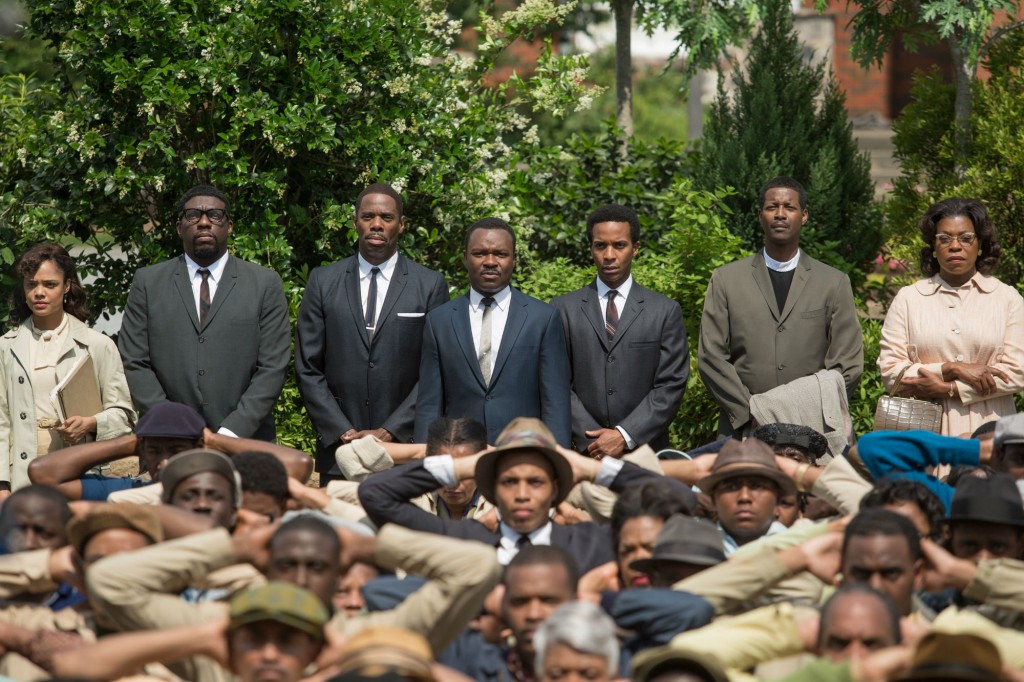Alex writes about Selma, American Sniper, and the way truth is presented in cinema.
When watching a movie that purports to be about something that occurred in real life, there are myriad ways to judge its makers’ intellect, but I prefer to focus on the two most frequently discussed ways. One can look at a film like Selma and say “That strays from some of the facts I read on Wikipedia; ipso facto, I am outraged,” or upon seeing American Sniper they can think, “Well, I guess this is a simple action movie that is forgoing facts.” Each of these options is in play for both movies, but typically some things are decided pretty quickly. Whenever you watch a film, there is a feeling-out process of sorts that happens between the movie and its viewers. With the first few minutes of a film, we immediately judge the merits of the picture, its stylistic choices, and its narrative structure. With an expertly-directed movie like Whiplash, the first scene shows us a microcosm of the movie itself: two people around a drum set, one teaching, one learning, and JK Simmons being tremendous. Historical dramas like American Sniper or Selma tell us in the opening how each film is going to treat history: whether it is going to try to shape it into something new and interesting, or fit what actually is interesting about the story into the pre-existing mould we’ve been making metaphorical lime Jello with for years. How we judge those few minutes typically ends up helping us decide how we are going to accept this film: as a piece of historical fiction that is interesting – and therefore we get upset when it strays from the truth – or a film that treats history so ludicrously as to completely invalidate its intended meaning.
Put simply, the storytelling qualities of each of these movies can be boiled down to one simple fact: I remembered how one movie begins, and totally forgot the other. Selma starts with Martin Luther King Jr. rehearsing a speech and talking to his wife about the perpetual silliness of ascots. Following that, while King gives the speech he was rehearsing, the film transitions to a scene of four schoolgirls walking down a set of stairs, having an innocuous conversation. I was confused by this sequence initially; I didn’t know who these girls were, nor why the scene was going on so long. And then a bomb goes off. The four girls are killed in what turns out to be the 16th Street Baptist Church Bombing, and as a viewer we learn even more about the environment the film exists within. Most importantly to the way we judge the film, we are learning this information in an interesting way. We’re asking questions until the film gives us the answers; we even see King asking questions of himself and his words before we see him speak them. With American Sniper, however, we know the answers long before we get to them. When I re-watched the introduction to American Sniper to jog my memory, I saw the film beginning in media res, and I recalled sitting in a theatre thinking, “Oh this is going to flash back to Kyle’s childhood.” A gunshot goes off, and we’re in the past, because of course we are.
Bradley Cooper and Clint Eastwood have each publically expressed their confusion about the way their film has been perceived. Each of them sees it as a film about post-traumatic stress disorder and the way war destroys a family, a viewpoint that is not hard to see when watching the actual film. But what neither man seems to realize is that they have made a terrible fucking movie about PTSD and the way war destroys a family. All of the thoughts about PTSD are clearly there – a man ignoring the effect war has had on him, that same man then lashing out irrationally, before finally being convinced that this is a real problem and accepting help. Kyle even aspires to help others, right up until a man suffering from PTSD murders him. This is all present in the film, and PTSD is the film’s villain (but not its most prevalent bad guy), because it indirectly kills our hero. Its depiction is simply not very interesting. American Sniper was never going to expose anybody to something we weren’t already aware of, something the film’s very basic level of examination ensures. Instead, the film focuses on idiotic action movie constructions – the enemy sniper, for example – without ever making a comment on them. These super villains are just people that exist to give Bradley Cooper PTSD, I guess. It was a construct we’ve seen in almost every action movie we’ve ever watched, so we immediately know how to understand it and roll our eyes at its idiocy. This is real life, we’ve been told. Real life has no single enemy that follows you around, we know instinctively. American Sniper is shenanigans, we think. This is something we see throughout the training sequences, Chris Kyle’s wedding, and pretty much every conversation Kyle has (especially stateside, where ideas are so unexamined that the film frequently transitions into accidental satire). We see the most basic version of these interactions, and we simply roll our eyes at them. Nothing else in the film ever had a chance.
Selma is interesting, though. The things people have taken the most umbrage with – outside of perhaps the rewriting of King’s speeches, because the originals are currently licensed to Dreamworks and Warner Brothers – is the way Lyndon Johnson has been treated. In Selma, LBJ is shown as a man willing to help Dr. King fight the good pacifistic fight, but seemingly only because Johnson cares about how history will perceive his actions. In a scene late in the film, he argues with George Wallace about why the march to Montgomery should be allowed, and Johnson’s key point seems to be that he doesn’t want to be on the wrong side of history. Selma depicts Johnson as a self-interested man, absolutely, maybe more so than he actually was, but the interesting thing it does is show (a fake version of) a real president thinking about how his actions will allow others to perceive him historically. Johnson’s desire to be seen as a man on the right side of history seems to trump his desire to actually be on the right side of history. I assume all presidents think about this constantly, and each subsequent president likely thinks about their image more than the one that came before him. Barack Obama is probably thinking about it right now. Once you get to a rarified place in history, by being drafted first overall in the NFL, or winning an Oscar, or being elected president, you have already started thinking about how history will perceive you. Once so many people have the ability to engage with you, your public perception gets increasingly out of your own control. You can continue to act in a manner you deem intelligent, but if you make a few of the wrong decisions, we will collectively judge you and, as every modern scandal seems to reinforce, you will lose.
Ava DuVernay’s version of Johnson cares about this very much, and it might be the most interesting moment in an otherwise fairly standard modern biopic. Selma perhaps strayed from the facts in telling its version of a true story, but at least the film strayed in fascinating ways. Capturing the absolute truth in fiction is inherently impossible; at least Selma had the smarts to be interesting while being unfaithful. Because Selma properly depicts the big moments, we are still willing to accept it as a good film even if it toys with history at points. Its manipulations are minimal and interesting; American Sniper’s are gigantic and obvious.
There is a simple way to understand Eastwood’s confusion with the film’s acceptance by America’s more writerly sorts. Eastwood is an eighty-four year-old man, and he makes movies in a manner eighty-four year-old men enjoy. American Sniper is a gorgeous, well-made film. The climax is arresting. I like classical filmmaking, and Eastwood’s death will coincide with the death of a certain kind of studio-system filmmaking he remains the last vestige of. But at this point, Eastwood’s storytelling sensibilities are basically garbage. (It is telling that the enemy sniper was added to the script by initial director Steven Spielberg, another person whose storytelling ideas could use some updating.) American Sniper’s introductory time shifting was probably something Eastwood falsely saw as incredibly modern, not unlike he saw himself offering the world a divergent thought to a genre he had been experiencing for eight decades. And Eastwood is a more forward-thinking person than his public image has ever shown; Dirty Harry is somewhat unbelievably a daily practitioner of transcendental meditation. This dichotomy of Eastwood’s actual self and his public persona is how 1992’s Unforgiven was able to be an interesting piece of pacifism. Eastwood turned a genre film on its head, engaging with his own violent iconography, and he made a gunslinger movie about the merits of not shooting people. He likely sees American Sniper’s treatment of PTSD in the same way, but enough time has passed that Eastwood’s broad view simply doesn’t translate into something interesting anymore.
Now, there is an elephant in the room whenever one talks about American Sniper: this movie has made a ton of fucking money. Absurd amounts. And the reason it has been able to do this is precisely because it aims for this simplistic sort of Middle America ideal. It’s about as mentally trying as Guardians of the Galaxy. Michael Bay’s jeans-manufacturing uncle once explained to Michael that to make money, one has to aim their product at Middle America, and American Sniper is digital denim. Thematically at least, Eastwood kind of made a slower-paced Michael Bay movie, whether Eastwood understands it or not. If American Sniper is about PTSD, Transformers: Age of Extinction was about drone strikes. As such, American Sniper becomes an abstract historical document of how the majority wants to remember a certain time in history, something that accidentally makes American Sniper very interesting. The film is popular today because it represents a viewpoint the majority of Americans still understand, because a majority of Americans (debatably) put George W. Bush in office for eight years. It is supported by the masses, and as such American Sniper ends up being a bizarrely accurate time capsule movie of how North America felt after 9/11. So the movie has merits, just not merits that make it mentally engaging. It’s a historical drama, but it only reminds the think piece writers and Kerry supporters of a time they all hated. Therefore, they transfer this distaste to the film, but people that represent the other side likely see it as an accurate reflection of their beliefs. I bet Tom Leykis fucking loves it.
Much has been said about Selma’s lack of Academy Award nominations, often contrasted with American Sniper’s overabundance of them. As a general rule, I don’t feel that the system in place has the capacity to reflect my cinematic opinions, so I try not to care. As such, I tend not to loudly argue about the Oscars except to say that your grandpa is the one who decides who is nominated. And your grandpa probably likes American Sniper, because a grandpa made American Sniper. This is not to say older directors don’t have the capacity to make movies of modernity – seventy-two year-old Michael Mann just made Blackhat, a movie that is equal parts terrible and stylistically adventurous. Martin Scorsese is Mann’s age, and The Wolf of Wall Street had a wonderfully modern tone. Terrence Malick is going to put out Knight of Cups this year, and I’ll probably adore it for its presumably unhinged narrative. But Eastwood makes movies in the simplistic way I described above; while these other aging directors have experimented with form, Eastwood takes a different approach. He takes the form we know and adds light commentary on PTSD into the mix, expecting that to be enough. Eastwood makes films on the path of least resistance, films that never confuse anybody. There’s never a moment where you don’t understand why these four girls are walking down this staircase, having a conversation about nothing, because everything in American Sniper can be understood immediately. It might not purport to be a documentary, but it wants to be seen as a reflection of a piece of history, which I guess it is, just not necessarily in the way it tries to be.
Veracity seems to be equal parts easier and more difficult to come across as time passes, as the amount of sheer information increases and sensible analysis of it gets dwarfed. We are perpetually inundated with information and various perspectives, but hamstrung by our lack of time to consume it all, and this inundation will continue to grow, because that is the only way it has gone for thousands of years. The number of things to know and voices to hear never goes down. Browser tabs will forever remain open but unread. As I age, this continued desire for an increase in knowledge becomes one of the more fascinating parts of human existence: I continually know more than I used to know, but gaining that knowledge somehow only ends up making life and everything within it seem more confusing. The more you learn, the less you understand how it all fits together. Increasingly, the only answer to the how seems to be, “It kind of doesn’t.” Even when we have complete video capture of everything that happens to us, like we’re all collectively living in Charlie Booker’s nightmares, things are still going to be open to interpretation. We’ll always find something to not know. At some point, you need to accept a sort of ignorance in order to get anywhere, lest you be stuck in a circular argument for the entirety of your life. American Sniper might be sliding its supporters a look at PTSD via a standard action vehicle that they might not otherwise see in a more complex narrative, just like Selma might be dumbing its treatment of LBJ down to engage with people on a different topic entirely. It is possible that each film is doing something positive in completely different ways. Understanding the way each picture is discussed in the media might all be as simple as the fact that American Sniper is much easier to make fun of.
No man is as simple as LBJ is depicted, nor Chris Kyle, nor Martin Luther King Jr. There is always more information to be had. In a two-hour biopic, you have to pick your spots and hope it helps the core themes you want your film to be about. But if the options are thoughtful ambiguity or comfortable ignorance, I will choose the former every time. That option will leave much open to interpretation, but it was always going to be anyway.






